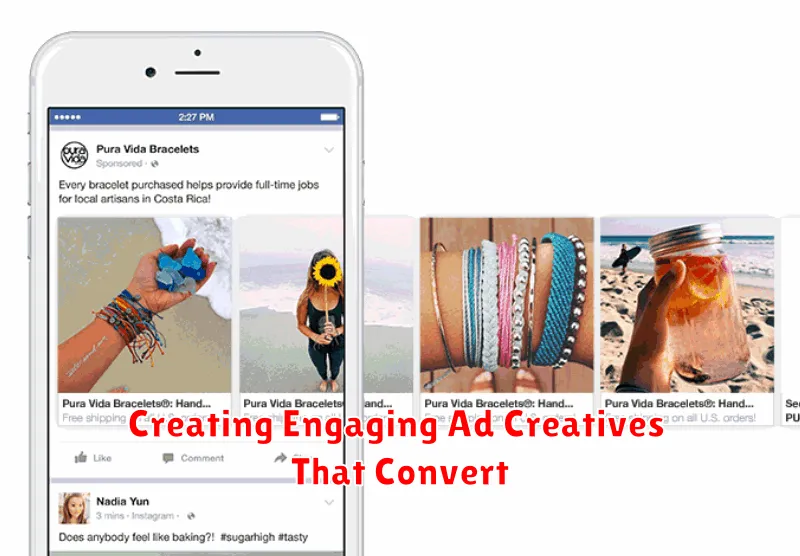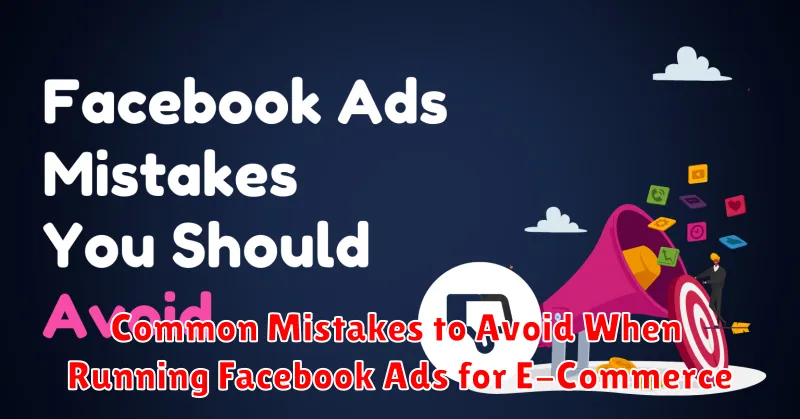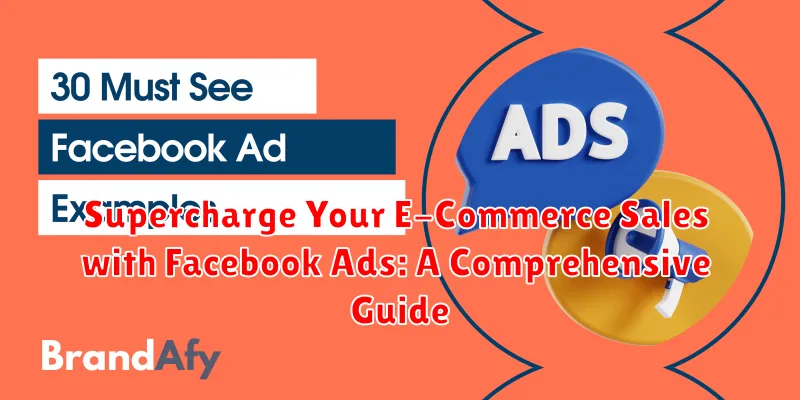Are you ready to supercharge your e-commerce sales? In today’s competitive digital landscape, leveraging the power of Facebook Ads is no longer optional, it’s essential. This comprehensive guide provides a detailed roadmap to harnessing the full potential of Facebook advertising for your e-commerce business. We’ll delve into strategies that can dramatically increase your conversions, expand your reach, and maximize your return on investment (ROI). Whether you’re a seasoned online retailer or just starting out, this guide offers valuable insights and actionable steps to elevate your e-commerce sales with Facebook Ads.
From targeting the right audience with laser precision to crafting compelling ad copy that resonates with potential customers, this guide covers all aspects of successful Facebook Ad campaigns for e-commerce. Learn how to create dynamic product ads, optimize your bidding strategies, and leverage powerful analytics to track your performance and refine your approach. Discover how to effectively utilize the Facebook Pixel and effectively retarget potential customers. Unlock the secrets to driving significant growth for your e-commerce business with this comprehensive guide to Facebook Ads.
Understanding the Power of Facebook Ads for E-Commerce
Facebook Ads offer unparalleled reach to connect with potential customers directly. With billions of active users, Facebook provides access to a vast and diverse audience, allowing you to precisely target individuals most likely to be interested in your products.
Targeted advertising is a key strength. Facebook’s detailed targeting options allow you to focus on demographics, interests, behaviors, and even specific life events. This ensures your ads are seen by the right people, maximizing your return on investment.
Beyond targeting, Facebook offers various ad formats to engage users effectively. From eye-catching image ads to dynamic product ads showcasing your inventory, you can choose the format that best showcases your products and resonates with your target audience.
Finally, Facebook Ads provide measurable results. Track key metrics like click-through rates, conversions, and return on ad spend to optimize campaigns and continuously improve your advertising performance. This data-driven approach empowers you to refine your strategies and achieve your e-commerce goals.
Setting Up Your Facebook Business Page for Success
A well-optimized Facebook Business Page is the foundation of successful e-commerce advertising. It’s the central hub where customers interact with your brand and learn more about your products.
First, ensure your Page’s profile and cover photos are high-quality and represent your brand effectively. Your profile picture should be easily recognizable, even at small sizes.
Next, complete the ‘About’ section with accurate and detailed information about your business, including your website, contact details, and a compelling brand story. This information builds trust and credibility.
Choose relevant categories that accurately reflect your business. This helps Facebook understand your offerings and target the right audience.
Finally, add a call to action button. Encourage visitors to take the next step, whether it’s visiting your website, shopping your products, or contacting you directly.
Targeting the Right Audience for Your Products
Targeting is crucial for Facebook ad success. Reaching the right audience ensures your budget is used efficiently and your ads are shown to potential customers. Facebook offers powerful targeting options to refine your audience selection.
Use demographics such as age, gender, location, and language to narrow down your audience. Interests targeting lets you reach people based on their hobbies, activities, and pages they follow. Consider targeting users based on behaviors like previous purchases or device usage.
Custom audiences allow you to re-engage existing customers or website visitors. Upload customer lists or create audiences based on website traffic. Lookalike audiences expand your reach by finding new people similar to your best customers. Experiment with different targeting options to identify what works best for your products.
Refine your targeting regularly. Analyze campaign performance and adjust your audience based on results. This continuous optimization will help you reach the most qualified potential buyers.
Creating Engaging Ad Creatives That Convert

Visual appeal is paramount. High-quality images and videos are crucial for grabbing attention in a crowded newsfeed. Showcase your products in a lifestyle setting, highlighting their benefits and uses. Consider using short, dynamic video ads, as they tend to outperform static images.
Craft compelling ad copy that speaks directly to your target audience. Highlight the unique selling points of your products and address pain points. Use strong calls to action that encourage immediate engagement, such as “Shop Now,” “Learn More,” or “Get a Free Quote.”
A/B testing different ad creatives is essential. Experiment with various images, videos, copy, and headlines to see what resonates best with your target audience. Analyze the results and refine your approach based on the data.
Consider incorporating user-generated content (UGC) into your ad creatives. UGC builds trust and social proof, showcasing real people enjoying your products. Request permission from customers to use their photos or videos in your ads.
Choosing the Right Facebook Ad Campaign Objective
Selecting the correct campaign objective is crucial for your Facebook Ads success. Your objective dictates how Facebook optimizes your ads and influences which metrics are prioritized. Aligning your objective with your desired outcome is the first step towards achieving your e-commerce goals.
Facebook offers a variety of campaign objectives categorized into three main groups: Awareness, Consideration, and Conversion.
Awareness
If your goal is to introduce your brand or products to a wider audience, an awareness campaign is a good starting point. Focus on reach and brand awareness objectives here.
Consideration
When you want potential customers to learn more about your products, drive traffic to your website, or encourage engagement, select a consideration objective like traffic, engagement, app installs, video views, lead generation, or messages.
Conversion
For e-commerce, the conversion objective is often the most relevant. This objective focuses on driving sales, catalog sales, or store traffic. Within the conversion objective, you can further refine your targeting to optimize for specific actions like adding to cart or purchasing.
Optimizing Your Facebook Ad Campaigns for Maximum ROI
Optimizing your Facebook Ad campaigns is crucial for achieving maximum return on investment (ROI). This involves continuous monitoring, testing, and refinement to ensure your ads are reaching the right audience with the right message at the right time.
Targeting is paramount. Utilize Facebook’s detailed targeting options to focus on demographics, interests, and behaviors relevant to your products. Experiment with different audience segments to identify high-performing groups.
A/B testing different ad creatives, including images, videos, and copy, is essential. This allows you to determine which variations resonate most effectively with your target audience and drive conversions.
Regularly analyze your campaign metrics. Pay close attention to key performance indicators (KPIs) such as click-through rate (CTR), conversion rate, and cost per conversion. Use this data to inform your optimization strategies and refine your campaigns for better performance.
Budget allocation also plays a significant role. Continuously monitor your campaign spending and adjust your budget allocation based on the performance of different ad sets and audiences. Shift resources towards high-performing segments to maximize your ROI.
Measuring Your Facebook Ads Performance and Making Data-Driven Decisions
Effectively measuring your Facebook Ads performance is crucial for optimizing campaigns and maximizing your return on investment (ROI). Key Performance Indicators (KPIs) provide valuable insights into what’s working and what needs adjustment.
Track essential metrics such as:
- Click-Through Rate (CTR): The percentage of people who see your ad and click on it. A higher CTR indicates a more engaging ad.
- Conversion Rate: The percentage of clicks that result in a desired action, such as a purchase. This metric directly reflects the effectiveness of your sales funnel.
- Cost Per Conversion (CPC): The average cost you pay for each conversion. Lowering your CPC is key to profitability.
- Return on Ad Spend (ROAS): The revenue generated for every dollar spent on advertising. A higher ROAS signifies a successful campaign.
Utilize Facebook Ads Manager and reporting tools to monitor these KPIs. Analyze the data to identify trends and patterns. For example, a low CTR might suggest the need for more compelling ad creatives, while a low conversion rate could indicate issues with your landing page or checkout process.
By consistently monitoring and analyzing your Facebook Ads performance, you can make informed decisions about budget allocation, targeting, and ad creatives, ultimately driving better results.
Common Mistakes to Avoid When Running Facebook Ads for E-Commerce

Running successful Facebook Ad campaigns requires a keen understanding of the platform and its nuances. Avoid these common pitfalls to maximize your return on investment.
Poor Targeting
Define your audience. Don’t cast too wide a net. Utilize Facebook’s detailed targeting options to reach the most relevant users based on demographics, interests, and behaviors. Failing to do so leads to wasted ad spend and low conversion rates.
Ignoring Mobile Optimization
The majority of Facebook users access the platform via mobile devices. Ensure your landing pages and ad creatives are mobile-friendly for a seamless user experience. A poor mobile experience can significantly deter potential customers.
Neglecting A/B Testing
Test everything. From ad copy and visuals to targeting parameters and bidding strategies, A/B testing allows you to identify what resonates best with your audience. Don’t assume what works; let the data guide your decisions.
Setting and Forgetting
Monitor your campaigns. Regularly analyze performance metrics and make necessary adjustments. The Facebook advertising landscape is dynamic. What worked yesterday might not work today. Consistent monitoring is crucial for sustained success.

